14.5.1: Tetrahedral and Octahedral Oxides
- Page ID
- 18660
Tetrahedral Oxides
zincite ZnO
Octahedral Oxides
rutile TiO2
periclase MgO
hematite Fe2O3
corundum Al2O3
ilmenite FeTiO3
cassiterite SnO2
pyrolusite MnO2
columbite (Fe,Mn)Nb2O6
tantalite (Fe,Mn)Ta2O6
Similar to the sulfides, mineralogists divide oxide minerals into those having metal ions only in tetrahedral or only in octahedral coordination, and those in which the ions occupy sites with mixed or unusual coordinations. Zincite, a rare mineral, is the only known example of a purely tetrahedral oxide, but more than a dozen octahedral oxides are known. At high temperatures, Mg-, Fe-, and Ti-oxides form stable solid solutions. At low temperatures, most intermediate compositions are unstable; consequently, exsolution is common.
For more general information about oxides, see Section 9.2.3 in Chapter 9.
Zincite ZnO
Origin of Name
Zincite is named for its composition.
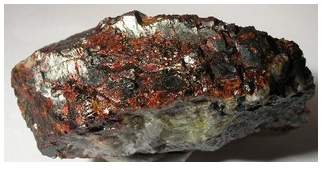
Hand Specimen Identification
Zincite is identified by its association with other Zn-minerals (most commonly willemite and franklinite), its orange-yellow streak, and its common red color. Other colors are possible, making identification sometimes difficult. The specimen in Figure 14.314 comes from a famous Zn-mineral collecting site in New Jersey.
Physical Properties
| hardness | 4 to 4.5 |
| specific gravity | 5.4 to 5.7 |
| cleavage/fracture | perfect basal (001)/subconchoidal |
| luster/transparency | subadamantine/translucent |
| color | orange, yellow to deep red; rarely other colors |
| streak | orange-yellow |
Properties in Thin Section
Zincite is uniaxial (+), ω = 2.013, ε = 2.029, δ = 0.016.
Crystallography
Zincite is a hexagonal mineral, a = 3.25, c = 5.19, Z = 2; space group P63mc; point group 6mm.
Habit
Zincite specimens are typically massive, platy, or granular. Rare crystals are hexagonal prisms terminated by pyramids and pedions.
Structure and Composition
Zincite has the same structure as wurtzite; Zn is hexagonal closest packed. Mn and minor Fe may substitute for Zn.
Occurrence and Associations
Zincite is a rare mineral, primarily found at Franklin, New Jersey. Associated minerals include calcite, dolomite, franklinite, and willemite.
Related Minerals
Zincite is isostructural with wurtzite, ZnS; enargite, Cu3AsS4; and greenockite, CdS.
Rutile TiO2
Origin of Name
From the Latin word rutilas, meaning “red.”
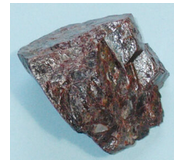
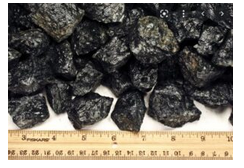
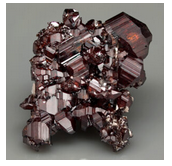
Hand Specimen Identification
Red-brown to reddish-black color and adamantine luster are keys to rutile identification. When present, tetragonal prismatic crystals aid identification. Figures 14.315 and 14.316 show typical anhedral examples.
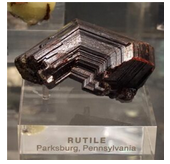
Reddish rutile, such as the rutile seen in Figure 14.315, is significantly more common than black rutile (Figure 14.316) Most rutile occurrences are very fine-grained, but when coarse and euhedral, rutile may be in spectacular specimens, typically crystal clusters (Figure 14.317). Rutile also, sometimes, develops diagnostic cyclic twins like those seen in Figure 14.318.
Physical Properties
| hardness | 6 to 6.5 |
| specific gravity | 4.24 |
| cleavage/fracture | good prismatic {100} and {110}/subconchoidal |
| luster/transparency | adamantine, submetallic/transparent to translucent |
| color | red, red-brown to black |
| streak | pale or light brown |
Properties in Thin Section
Rutile appears deep red, red-brown, or yellow-brown in thin section. The strong color may mask its extreme birefringence. Relief is very high. Uniaxial (+), ω = 2.61, ε = 2.90, δ = 0.29.
Crystallography
Rutile is a tetragonal mineral, a = 4.59, c = 2.96, Z = 2; space group \(P\dfrac{4_2}{m}\dfrac{2_1}{n}\dfrac{2}{m}\); point group \(\dfrac{4}{m}\dfrac{2}{m}\dfrac{2}{m}\).
Habit
Rutile may be massive but more commonly forms stubby to acicular tetragonal crystals. Striated prismatic crystals, terminated by prisms and often twinned, are common.
Structure and Composition
In rutile, distorted TiO6 octahedra share edges to form chains. Chains are connected by corner-sharing octahedra. Each O is in triangular coordination, bonded to three Ti. Fe, Ta, Nb, V, Sn, and Cr may be present as substitutions. Minerals with similar structures to rutile include cassiterite, SnO2; pyrolusite, MnO2; plattnerite, PbO2; and stishovite, SiO2.
Occurrence and Associations
Rutile, although not particularly abundant, is widespread. It is found typically as small grains in intermediate to mafic igneous rocks, in some metamorphic rocks, in veins, in pegmatites, and in some sediments. It sometimes occurs as needles in quartz. Associated minerals include quartz, feldspar, ilmenite, and hematite.
Varieties
Sagenite is the name given to rutile that exists as needled patches within other minerals such as quartz and pyroxene.
Related Minerals
Rutile has several polymorphs; most important are anatase and brookite.
Periclase MgO
Origin of Name
From the Greek words peri and klasis, meaning “even” and “fracture,” referring to its perfect cubic cleavage.

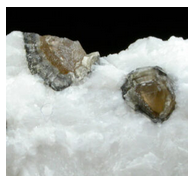
Hand Specimen Identification
Clear or light color, equant granular crystals, cubic cleavage (if visible), and occurrence in marbles help identify periclase. Most periclase occurs as very fine grains in metadolomites.
These two photos show examples of periclase. In these photos, white dolomite surrounds green and brown periclase crystals. Periclase (Mg-oxide) commonly alters to brucite (Mg-hydroxide); the periclase crystals in Figure 14.320 have brucite rims.
Physical Properties
| hardness | 5.5 |
| specific gravity | 3.56 |
| cleavage/fracture | perfect {100}, poor {111}/ uneven |
| luster/transparency | vitreous/transparent to translucent |
| color | colorless or gray, rarely yellowish or brown |
| streak | white |
Properties in Thin Section
Periclase is colorless in thin section, has high relief and cubic cleavage. Isotropic, n = 1.736.
Crystallography
Periclase is cubic, a = 4.21, Z = 4; space group \(F\dfrac{4}{m}\overline{3}\dfrac{2}{m}\); point group \(\dfrac{4}{m}\overline{3}\dfrac{2}{m}\).
Habit
Typically periclase crystals are cubes or octahedra. Coarse or granular masses are common.
Structure and Composition
In periclase, Mg and O alternate in a three-dimensional cubic framework. Fe, Zn, and minor Mn may substitute for Mg. Halite (NaCl), sylvite (KCl), galena (PbS), periclase (MgO) and several other minerals are isostructural.
Occurrence and Associations
Periclase is a high-temperature mineral found in metamorphosed carbonates. It is typically in contact aureoles, associated with calcite, forsterite, diopside, and a number of other Ca- and Ca-Mg-silicates.
Related Minerals
Periclase is isostructural with halite (NaCl), sylvite (KCl), galena (PbS), periclase (MgO) and several other minerals.
Hematite Fe2O3
Origin of Name
From the Greek word haimatos, meaning “blood,” a reference to its color when powdered.
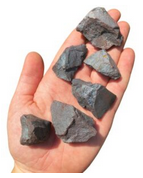


Hand Specimen Identification
Hematite has variable appearance, but high density, dark color, and a characteristic red streak are keys to identification. If red, hematite may sometimes be confused with cinnabar, another red mineral.
The photos seen above are typical. Figure 14.321 is a photo of hematite displaying variable reddish-brown hues. Figure 14.322 is a photo of a crystal displaying the mineral’s hexagonal symmetry. Figure 14.323 is a photo of botryoidal hematite. Hematite‘s luster is variable from earthy to metallic. Figure 14.324, below, shows a particularly metallic variety of the mineral called specular hematite.
Physical Properties
| hardness | 5.5 -6.5 |
| specific gravity | 4.9 to 5.3 |
| cleavage/fracture | none/subconchoidal |
| luster/transparency | submetallic/translucent to opaque |
| color | steel-gray, red-brown to black |
| streak | red |
Properties in Thin Section
Hematite is usually opaque; when thin, it may have a deep red color. Uniaxial (-), ω = 3.22, ε = 2.96, δ = 0.28.
Crystallography
Hematite crystals are trigonal. a = 5.04, c = 13.76, Z = 6; space group \(R\overline{3}\dfrac{2}{c}\); point group \(\overline{3}\dfrac{2}{m}\).
Habit
Hematite exhibits many habits. Aggregates may be massive, in rosettes, botryoidal, reniform, micaceous and foliated, or earthy. Individual crystals are tabular, with many forms making up the faces. Twins are common.
Structure and Composition
Hematite‘s structure is similar to that of corundum. Closest packed O2- forms hexagonal layers; Fe3+ occupies two of three interlayer octahedral sites. FeO6 octahedra, linked by edge sharing, form 6-sided rings. Ti, Fe, Al, and Mn may replace Fe in small amounts.
Occurrence and Associations
Hematite is a common mineral in many kinds of rocks. It is found in red sandstones, iron formations, and their metamorphic equivalents; as an accessory mineral in igneous rocks; as coatings and nodules; and in hydrothermal veins. Hematite is also associated with altered zones of ore deposits where it is typically secondary, forming after magnetite, Fe-sulfides, or Fe-silicates.
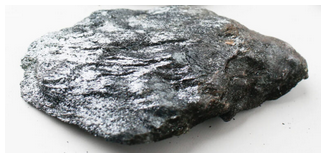
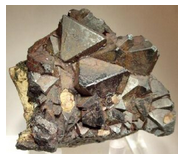
Varieties
Specular hematite, also called specularite, is the name given to micaceous or massive hematite exhibiting a splendent metallic luster (Figure 14.324). Martite is the name given to hematite pseudomorphs after magnetite (Figure 14.325). Ocher is a red, earthy form of hematite.
Related Minerals
Hematite has a rare polymorph, maghemite. Isostructural minerals include corundum, Al2O3; eskolaite, Cr2O3; and karelianite, V2O3. Turgite, 2Fe2O3•nH2O, and limonite, Fe2O3•nH2O, are equivalent to hydrated hematite with variable water content. Other related minerals include goethite and lepidocrocite, both FeO(OH), and bixbyite, Mn2O3.
Corundum Al2O3
Origin of Name
Derived from kauruntaka, the Indian name for the mineral.

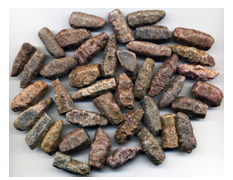
Hand Specimen Identification
Corundum is identified primarily by its hardness and crystal shape. Figure 14.326 shows typical hexagonal cross sections. Figure 14.327 is a photo of diagnostic subhedral to euhedral barrel-shaped crystals. Luster, specific gravity, and habit aid identification.
Corundum comes in many colors, but the red and brown colors seen in the figures above are the most common. Other colors are, however, well known. Figure 3.41 shows some examples. Many colored varieties have gem names (see Figures 14.328, 14.329, and 14.330, below).
Physical Properties
| hardness | 9 |
| specific gravity | 3.9 to 4.1 |
| cleavage/fracture | none/uneven; rectangular parting |
| luster/transparency | adamantine/transparent to translucent |
| color | shades of brown, blue, red, pink, colorless, variable |
| streak | white |
Properties in Thin Section
In thin section, corundum is typically colorless. Some varieties are pale pink, green, blue, or yellow. It has extremely high relief and is weakly birefringent. Uniaxial (-), ω = 1.768, ε = 1.760, δ = 0.008.
Crystallography
Corundum belongs to the trigonal crystal system. a = 4.95, c = 13.78, Z = 6; space group \(R\overline{3}\dfrac{2}{c}\); point group \(\overline{3}\dfrac{2}{m}\).
Habit
Hexagonal corundum crystals may be tabular or prismatic. Multiple pyramidal forms combined with pinacoids give a tapering or barrel-shaped appearance. Euhedral individual crystals are rare; corundum is usually massive or granular.
Structure and Composition
The corundum structure is identical to that of hematite (see hematite structure, above). Minor amounts of Fe, Ti, Cr, Ni, and Mn replace Al.
Occurrence and Associations
Corundum is an accessory mineral in metamorphosed carbonates and sediments, in some Al-rich igneous rocks, and in placers. Massive corundum with iron oxides, forming emery deposits, is found in carbonate skarns.

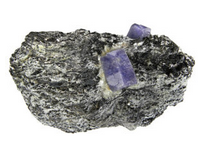
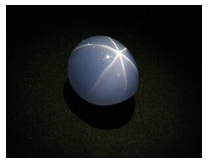
Varieties
Ruby (always red) and sapphire (typically blue but sometimes other colors) are gem varieties of corundum. Figures 14.328 and 14.329 show crystals of ruby and sapphire. Figure 14.330 is a photo of the Star of India, one of the largest star sapphire cabochons in the world.
Related Minerals
Corundum is isostructural with hematite (Fe2O3), ilmenite (FeTiO3) eskolaite (Cr2O3) and karelianite (V2O3).
Ilmenite FeTiO3
Origin of Name
Named after the Ilmen Mountains in Russia.
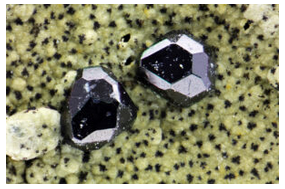
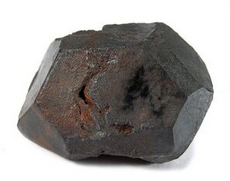
Hand Specimen Identification
Density and black color help identify ilmenite. It is distinguished from magnetite by its lack of strong magnetism and from hematite by its (not red) streak. Ilmenite is occasionally confused with chromite.
The photos here show typical ilmenite crystals. Ilmenite is generally in the form of small crystals, like those in Figure 14.331. The larger crystal seen in Figure 14.332 is quite exceptional. Figure 9.55 shows another exceptional example, a large hexagonal ilmenite crystal from Quebec.
Physical Properties
| hardness | 5.5 to 6 |
| specific gravity | 4.5 to 5 |
| cleavage/fracture | none/subconchoidal |
| luster/transparency | metallic/opaque |
| color | iron-black |
| streak | brownish red to black |
Crystallography
Ilmenite crystals are trigonal. a = 5.08, c = 14.08, Z = 6; space group R3; point group 3.
Habit
Ilmenite crystals are tabular or prismatic, often showing rhombohedral forms, and commonly twinned. The most common occurrences are massive, granular, compact, scaly, or appearing as skeletal crystals.
Structure and Composition
Ilmenite is isostructural with hematite (Fe2O3), corundum (Al2O3) eskolaite (Cr2O3) and karelianite (V2O3). Ilmenite may contain excess Fe replacing Ti, forming limited solid solutions with hematite. Mg and Mn may replace Fe.
Occurrence and Associations
Ilmenite, a common vein mineral, is found as masses in igneous rocks, in pegmatites, as an accessory in high-grade metamorphic rocks, and is present in black sands where associated minerals include quartz, hematite, magnetite, rutile, zircon, monazite, and other dense minerals.
Related Minerals
Geikielite, MgTiO3, and pyrophanite, MnTiO3, form complete solid solutions with ilmenite.
Cassiterite SnO2
Origin of Name
From the Greek word kassiteros, meaning “tin.”
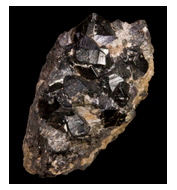
Hand Specimen Identification
Cassiterite is recognized by crystal shape, dark color but white streak, high specific gravity, indistinct prismatic cleavage, and adamantine luster. Thin crystals may be translucent. Cassiterite has historically been the most important tin ore mineral. Because of its adamantine luster, it is sometimes valued as a gemstone. It may be confused with rutile if it has a deep reddish-brown-black color.
Physical Properties
| hardness | 6 to 7 |
| specific gravity | 7.0 |
| cleavage/fracture | good {100}, poor {111}/ subconchoidal |
| luster/transparency | adamantine/transparent to translucent |
| color | brown or black, sometimes reddish |
| streak | white |
Properties in Thin Section
Cassiterite is yellow, brown, red, or colorless in thin section. Relief and birefringence are high. Uniaxial (+), ω = 2.006, ε = 2.097, δ = 0.091.
Crystallography
Cassiterite is tetragonal, a = 4.74, c = 3.19, Z = 2; space group \(P\dfrac{4_2}{m}\dfrac{2_1}{n}\dfrac{2}{m}\); point group \(\dfrac{4}{m}\dfrac{2}{m}\dfrac{2}{m}\).
Habit
Cassiterite crystals are pyramidal, stubby prismatic, or acicular. Faces may be striated. Contact and penetration twins are common; complex multiple twinning is less common. Cassiterite may be massive, colloform, reniform, or fibrous.
Structure and Composition
In cassiterite, distorted SnO6 octahedra share edges to form chains. Chains are connected by corner-sharing octahedra. Each O is in triangular coordination, bonded to three Sn. Cassiterite may contain minor Fe and Ta substituting for Sn. Mn, W, Nb, and Sc also may be present in trace amounts.
Occurrence and Associations
Cassiterite is widespread but rarely concentrated as tin ore. It occurs in pegmatites, veins, contact aureoles, altered zones of ore deposits, and placers. Associated minerals include quartz, topaz, tourmaline, fluorite, muscovite, lepidolite, wolframite, scheelite, and others.
Related Minerals
Cassiterite is isostructural with rutile, TiO2; pyrolusite, MnO2; plattnerite, PbO2; and paratellurite, TeO2.
Pyrolusite MnO2
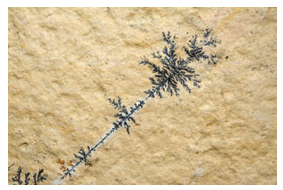
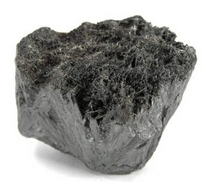
Origin of Name
From the Greek words pyr and louein, meaning “fire” and “to wash,” referring to its use in glass manufacturing.
Hand Specimen Identification
Metallic luster, extreme softness (H = 1 to 2), sooty character, and a black streak characterize pyrolusite. Occurrence as arborescent dendrites (Figure 14.334), similar in appearance to snowflakes or frost on windows, is diagnostic. Massive samples, such as the one in Figure 14.335, may be difficult to distinguish from other dense black minerals.
Physical Properties
| hardness | 1 to 2 |
| specific gravity | 4.5 to 5.0 |
| cleavage/fracture | perfect but rarely seen prismatic {110}/uneven |
| luster/transparency | metallic/opaque |
| color | black |
| streak | black or bluish-black |
Crystallography
Pyrolusite is tetragonal, a = 4.40, c = 2.87, Z = 2; space group \(P\dfrac{4_2}{m}\dfrac{2_1}{n}\dfrac{2}{m}\); point group \(\dfrac{4}{m}\dfrac{2}{m}\dfrac{2}{m}\).
Habit
Rare macroscopic crystals of pyrolusite are perfect tetragonal prisms. More commonly pyrolusite forms orthorhombic pseudomorphs after manganite, or it is dendritic, fibrous, reniform, or columnar.
Structure and Composition
Pyrolusite has the rutile structure (see rutile structure, above). It is commonly close to pure Mn-oxide, but Mn valence may be slightly variable. Small amounts of H2O may be present. Minerals with similar structures to rutile include cassiterite, SnO2; pyrolusite, MnO2; plattnerite, PbO2; and stishovite, SiO2.
Occurrence and Associations
Pyrolusite is a secondary mineral found as coatings, nodules, dendrites, and in beds. Associated minerals include barite, limonite, romanechite (psilomelane), hematite, magnetite, and other Mn- and Fe-oxides.
Varieties
Wad is the name for mixtures of Mn-oxides and hydroxides that include pyrolusite.
Related Minerals
Pyrolusite has several polymorphs, including nsutite, Mn(O,OH)2; ramsdellite, MnO2; and vernadite, (Mn,Fe,Ca,Na)(O,OH)2 · nH2O. Other related manganese minerals include manganite, MnO(OH); romanechite (psilomelane), BaMn9O16(OH)4; and birnessite, Na4Mn14O27•9H2O.
Columbite-Tantalite (Fe,Mn)(Nb,Ta)2O6
Origin of Name
Columbium, an early name for the element tantalum, is named after Columbia, where the original samples of columbite, (Fe,Mn)Nb2O6, were found. Tantalite, (Fe,Mn)Ta2O6, derives from the Greek myth of Tantalus. These two end members form a complete solid solution and are generally grouped together.
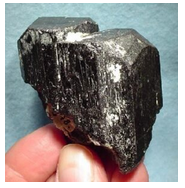
Hand Specimen Identification
Association, color, luster, streak, and density help identify members of the columbite–tantalite series, but distinguishing Nb-rich varieties from Ta-rich varieties is not possible without chemical analysis. Crystals often display heart-shaped twins – a hint of that shape is visible in Figure 14.336. These minerals may be confused with wolframite or uraninite, other dark-colored dense minerals.
Physical Properties
| hardness | 6 |
| specific gravity | 6.0 |
| cleavage/fracture | good (010)/subconchoidal |
| luster/transparency | submetallic/translucent to opaque |
| color | iron-black to brown |
| streak | brown, dark red to black |
Properties in Thin Section
Columbite-tantalite msinerals are biaxial (+), α = 2.44 , β = 2.32, γ = 2.38, δ = 0.12, 2V = 75°.
Crystallography
Columbite-tantalite minerals are orthorhombic, a = 5.10, b = 14.27, c = 5.74, Z = 4; space group \(P\dfrac{2_1}{b}\dfrac{2}{c}\dfrac{2_1}{n}\); point group \(\dfrac{2}{m}\dfrac{2}{m}\dfrac{2}{m}\).
Habit
Columbite-tantalite crystals are usually short prisms or tabs, sometimes with heart-shaped twins. Crystal aggregates and masses are common.
Structure and Composition
The structure of columbite-tantalite consists of chains of (Fe,Mn)O6 and (Nb,Ta)O6 octahedra. Edge sharing joins them together. Columbite, (Fe,Mn)Nb2O6, and tantalite, (Fe,Mn)Ta2O6 form a complete solid solution. Mg may substitute for (Fe,Mn). Sn and W may be present in small amounts.
Occurrence and Associations
Members of the columbite–tantalite series are uncommon. They occur in pegmatites with quartz, feldspar, mica, Li-minerals, phosphates, and other typical pegmatite minerals. They also occur in carbonatites and in placer deposits with other dense minerals.
Varieties
Tapiolite is a polymorph of columbite–tantalite. Other related minerals include microlite, Ca2Ta2O6(O,OH,F); pyrochlore, (Ca,Na)2(Nb,Ta)2O6(O,OH,F); and fergusonite, (REE)NbO4.


